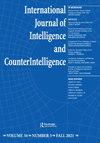联邦调查局的边境覆盖(BOCOV)计划和情报任务的模糊性
IF 0.5
Q4 INTERNATIONAL RELATIONS
International Journal of Intelligence and Counterintelligence
Pub Date : 2023-06-26
DOI:10.1080/08850607.2023.2221825
引用次数: 0
摘要
本文章由计算机程序翻译,如有差异,请以英文原文为准。
The FBI’s Border Coverage (BOCOV) Program and the Ambiguity of Intelligence Missions
Abstract Intelligence services must routinely operate in liminal spaces, both operationally and bureaucratically. The Border Coverage (BOCOV) Program of the Federal Bureau of Investigation (FBI) was a Cold War example of an agency seeking to address the vulnerability inherent to a geographic liminal space. Its implementation of the program illustrated the impact of bureaucratic borders—between the FBI and Central Intelligence Agency and between Intelligence Community (IC) and non-IC agencies. Lessons learned, through the implementation of BOCOV, about interagency relations continue to be applicable as the United States contends with the cyber environment, an even more porous space than the physical U.S.–Mexican border.
求助全文
通过发布文献求助,成功后即可免费获取论文全文。
去求助
来源期刊

International Journal of Intelligence and Counterintelligence
INTERNATIONAL RELATIONS-
CiteScore
1.00
自引率
22.20%
发文量
102
 求助内容:
求助内容: 应助结果提醒方式:
应助结果提醒方式:


